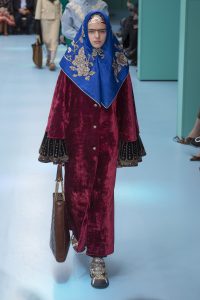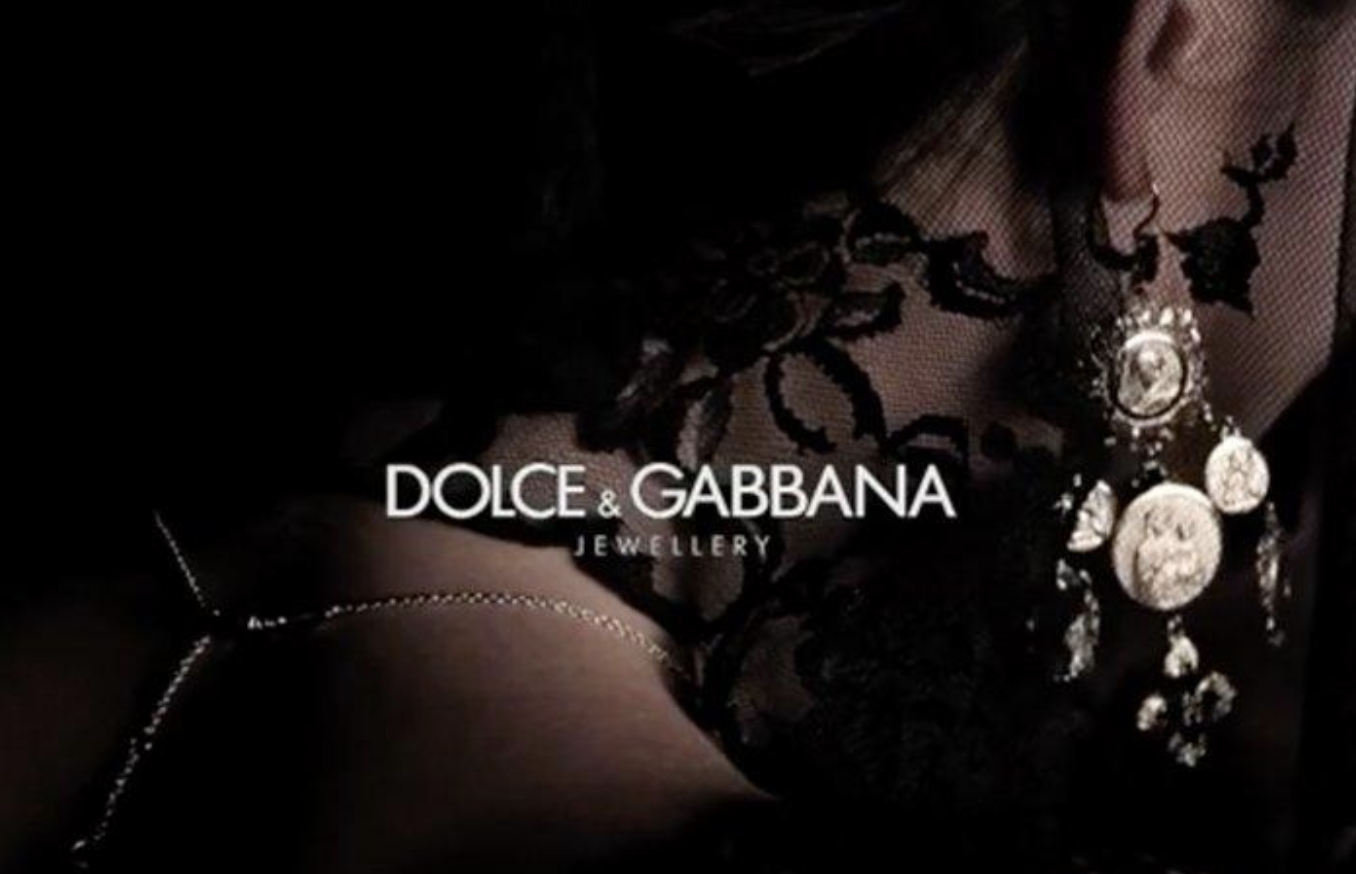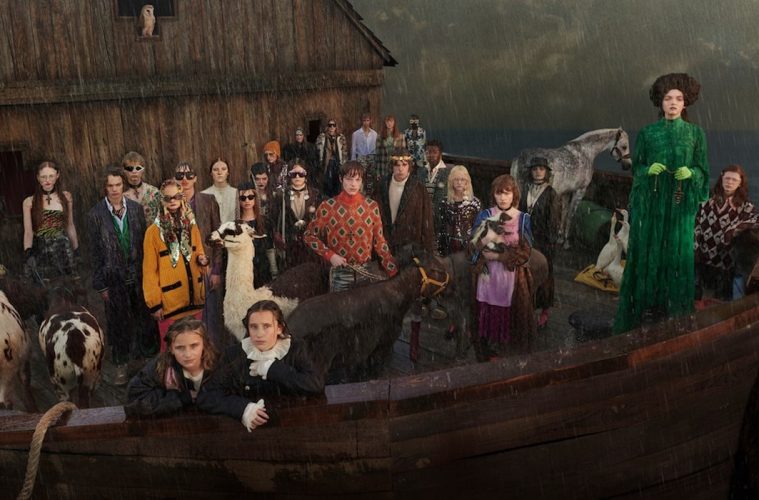By Celine Kempen
Copy editor Eliza Marks
Gucci created a unique aesthetic piece with its apocalyptic GucciGothic video, which advertises its 2019 collection. Director Glen Lunchford leans on the familiar biblical imagery of ‘Noah’s Ark,’ reinterpreting it to stage Gucci’s Cruise Collection designed by Italian fashion designer and appointed creative director since 2015, Alessandro Michele. The scene could be described as follows:
Two humans in a golden field, accompanied by ostriches. A white horse on a lead. Pairs of animals crossing a forest path- sheep, donkeys, llama, birds, elephants. They are making their way to a wooden ark being built by young farmers. Every scene is a painting. Soon enough, the romantic agricultural landscape will transform through an apocalyptic rain. The wooden ark with its passengers finds itself floating on a newly created ocean.
In Gucci’s words, “Young farmer-punks appear in a surreal, mythological world, where an agricultural landscape and the changing weather emphasize the power of nature.”
Michele and Lunchford’s religiously-imbued video set on Noah’s Ark, tells the iconic tale from the book of Genesis in which God instructs his prophet Noah to build an ark, saving his family and each of the world’s animal species from near-apocalyptic flooding. The idea was to save the world’s most beautiful creatures to continue life after the flood, but here, the chosen ones wearing the latest and most exquisite designs, of course. The story of Noah’s Ark holds significant religious symbolism in the Judaism and Christianity, and in Islam, though in a slightly different form. In the Qur’an, the flood becomes a regional event instead of the worldly flood it is in the Bible, and more than Noah and his family were accepted on the Ark. In the case of Gucci’s new ad campaign, which includes crosses and other religious imagery, it is among a Christian public that these images will unfold their full potential.
Considering that luxurious fashion is very popular in the Gulf, one might wonder why exactly the brand chose to give its line this framework. Who did it intent to address? I cannot know, but it makes me think of its reception by those with high purchasing power. How does this fashion speak for example to a woman in the Gulf? Would this ad be appealing to her? And more importantly, would it work the other way around? Would a Saudi or Qatari brand be able to sell its fashion in France, Italy and the US with an ad campaign heavily alluding to Islamic imagery? I’m assuming it wouldn’t spark people’s imagination unless they used the good old orientalist images like the niqab, coal-lined eyes, or camels against a desert backdrop. What does a good marketing strategy consist of? Is it meant to trigger peoples’ stereotypes and preconceptions, in this case about Christianism?

Shakira, Oral Fixation, 2005
Numerous fashion brands and artists used this strategy that leans heavily on to Christian imagery. A priest opened Christian Dior’s Haute Couture Fall/Winter 2000 fashion show. In 2013, Givenchy dressed their models as nuns in church vestments. Shakira’s Oral Fixation record covers of were inspired by Eve and the Garden of Eden. The singer explained that she wanted “to attribute to Eve one more reason to bite the forbidden fruit, and that would be her oral fixation” and that “[she always felt] that [she has] been a very oral person. [It is her] biggest source of pleasure”. Similarly to this image, the Lebanese singer, Maya Diab, posed for a jewelry ad from Voyageur in which she represented Eve. She is holding an apple, entwined by a snake, a heaven-like background surrounds the woman gazing seducingly into the camera.

Voyageur, Jewelry, 2014 (Maya Diab)
Dolce&Gabbana references Catholic imagery in its jewelry video “Dolce&Gabbana Jewelry: a precious passion.” In the video, a woman seduces a man and the two begin to passionately kiss. She startles when they are interrupted by calls from outside their luxurious apartment, and in the next scene we find her in a confessional, wearing the same jewelry and clothes, some of her skin around her neck revealed. Luxury and decadence, sinning and confessing, are all part of a Catholic frame of reference and are fetishized in this video, playing with that which is forbidden by Catholic morals while drawing attention to what the Catholic Church has been known for since Pope Borgia.

Gucci, Fall/Winter Ready-to-Wear, 2018
To combine these images with the brand draws them closely together, as if the brand were sacralised using this imagery. The same goes for Noah’s Ark. We shall not forget that Gucci and Dolce&Gabbana are both Italian brands, a country with strong ties to Catholicism. They use and twist the common imagery to make profit, while at the same time emphasizing their heritage and tradition in the fashion industry that is strongly associated to Italy. In contrast, it is interesting to observe that French brands like Christian Dior and Givenchy use religious symbology despite its active removal from French public space, as we have recently seen with the ban on the burkini, which is characteristic of the country perhaps since the French Revolution in 1789 and its move toward secularism.
On one hand, considering the brands’ background, I am content that they are using imagery that corresponds to their history of Italian or French Catholicism. On the other hand, I am wondering if that means that they are not appropriating. How religious are these signs after all? Haven’t they just become an accessory or part of a marketing strategy? I don’t see a practicing Christian wearing oversize crosses on chains or dangling from BDSM bondage collars. To my understanding, that would contradict Jesus’ message of humility and modesty as does the above-mentioned decadence and extravagance of the Church. If the religious character has been eliminated, it is appropriation, right?
Dolce&Gabbana has been accused of appropriation multiple times. One example is its 2016 Abaya “Ready.To-Wear” Collection that is mostly sold in the Gulf, which resulted in allegations of its appropriating Islamic dress for economic profit. There is indeed a significant difference between Dolce&Gabbana referencing Catholic imagery and symbolism and Islamic. In the former case, they seem to be drawing on their own tradition, whereas in the latter, they act as the dominant culture taking elements of the “oriental” culture for commercial profit. We must consider their art, like anything else, in light of postcolonial power relations.

Dolce&Gabbana, Precious Passion Jewellery, 2016
I then wonder about myself, about these religious ad campaigns seduce and speak to me. What does that say about me? I have a Catholic background, but am not a practicing Christian, and I do have a weakness for extravagant fashion. Maybe it works because I have just enough distance to not consider this ad blasphemy, and just enough that makes me still susceptible to Christian imagery and the ‘coolness’ of crosses that is as old as time. I can’t even explain to myself. I am assuming that I find something of myself in this ad and its hipster vibe, its gender fluid fashion, the religiosity that lend it a little bit of mystery. Maybe this fashion has created this ad campaign not for its richest fans in the Gulf, but for people like me, people who might go to mass twice a year and find that churches are pleasant places of silence and spiritual retreat. So, can fashion inspired by religion only be effective on a person that lives a rather secular life?

